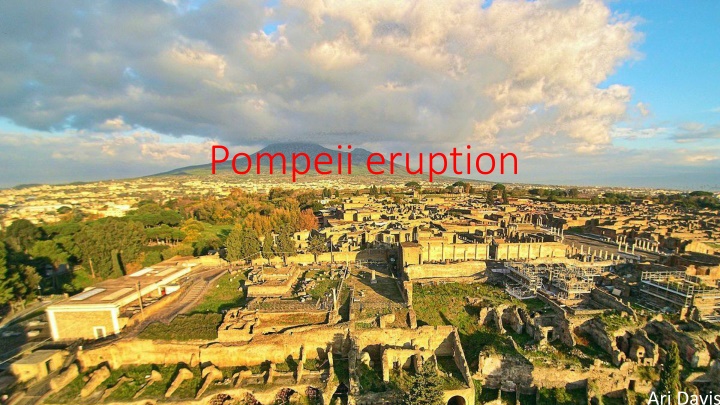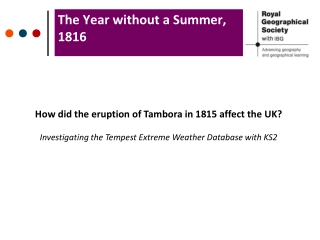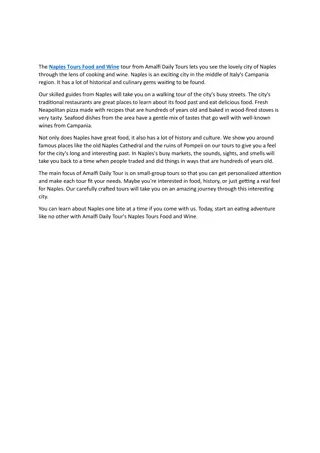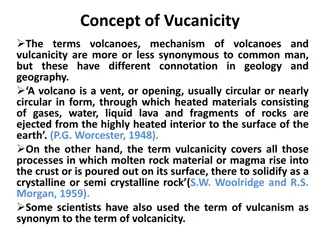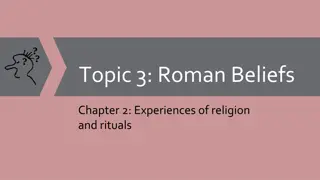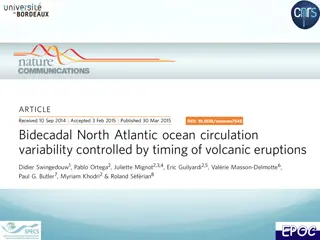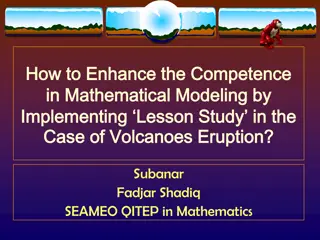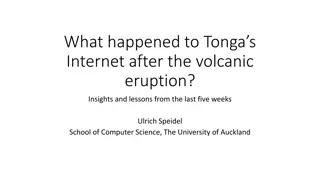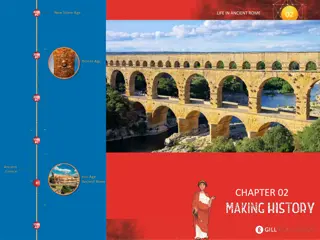Pompeii eruption
Ancient town Pompeii buried under Mt. Vesuvius eruption in 79 A.D. Discover how life was abruptly ended, leaving behind a preserved glimpse of the past.
Download Presentation

Please find below an Image/Link to download the presentation.
The content on the website is provided AS IS for your information and personal use only. It may not be sold, licensed, or shared on other websites without obtaining consent from the author.If you encounter any issues during the download, it is possible that the publisher has removed the file from their server.
You are allowed to download the files provided on this website for personal or commercial use, subject to the condition that they are used lawfully. All files are the property of their respective owners.
The content on the website is provided AS IS for your information and personal use only. It may not be sold, licensed, or shared on other websites without obtaining consent from the author.
E N D
Presentation Transcript
Pompeii eruption Ari Davis
Brief description Pompeii Is an ancient town located in Italy at the bottom of Mt. Vesuvius Mount Vesuvius, has erupted more than 50 times. Its most famous eruption took place in 79 A.D., when the volcano buried the ancient Roman city named Pompeii under volcanic ash. After the eruption dust filled the land and the city with darkness like the blackness of a night sky. In the disasters 2 thousand people died, and the city was abandoned for almost as many years. When a group of explorers rediscovered the site in 1748, they were shocked to find that Pompeii was intact underneath a large layer of dust and debris. The buildings and skeletons left behind in the city helped archeologists learn a lot about how the ancient people of Pompeii lived.
Before During and After Before Mt. Vesuvius erupted the city of Pompeii was living in caution knowing that, their village foundations where routed on a active volcano. Besides that everything resembled that of any other village in that time period. When the volcano started to erupt it was the middle of the night and the people of Pompeii where asleep, the loud nature of the volcano woke the citizens up, but it was too late to escape. The smoke took to the air, polluting it. While ash, gases and magma reign down on the village of Pompeii, slowly building in size. After Mt. Vesuvius erupted it left no life behind killing the entire village of Pompeii, polluting the air, water, and nature. As well as reigning havoc on all other villages nearby.
The 4 spheres description Atmosphere The Atmosphere is the air and gases on earth, it is what surrounds us at all times Hydrosphere The Hydrosphere is all the water on earth no madder what properties it`s in, Gas, Solid, and Liquid water all fall into the hydrosphere Geosphere The Geosphere is all the Earth`s layers including the surface we live on. Biosphere - The biosphere is all living beings on earth, Animals, Plants, Humans all fall into the Biosphere category.
The 4 spheres Biosphere The eruption of Mt. Vesuvius left all life within 4 Million feet being affected by the explosion, and all life within Pompeii dead, do to all the harmful gases like sulfur that where emitted along with magma and other harmful materials. Geosphere The earth's surface near Mt. Vesuvius after the disaster was littered with all kinds of garbage including ash, lava, rocks, and the belongings of the citizens of Pompeii Atmosphere The air was filled with smoke, ash, and gases that blew in the wind and carried over to neighboring villages the disaster left the sky looking more grey than blue. Hydrosphere The water along with all the other spheres was polluted with rocks\minerals, ash, skeletons, etc. After the disaster everything turned to ashes.
Connections 1. The, smoke, ash, sulfide, and other poisonous gases, the volcano emitted into the atmospheres. Tons of trees, farms, houses, etc. Were burned down in the volcanic eruption, and the geosphere was forever changed. Due to the sudden volcanic eruption all life near the volcano was killed and the biosphere was gone for hundreds of years. After the disaster, the build-up of ash, lava, volcanic rocks, etc. Was drained into the hydrosphere and kept polluting it every time Mt. Vesuvius erupted. When the volcano erupted the atmosphere carried that ash and smoke and tons of poisonous gases all over the neighboring villages filling them with a sky more resembling night than day. The disaster at Mt. Vesuvius left the ground around it corrupted, and any chance of growing crops in Pompeii gone. Making it so nobody could live in Pompeii. The disaster not only killed all human life at Pompeii but left the homes of animals near It destroyed and killed tons of wildlife. It also polluted the water source of any animal that wanted to life there. 2. 3. 4. 5. 6. 7.
How did Pompeii impact the environment and space around it? Mt. Vesuvius killed all forms of live around it, it killed the people trying to live, it killed nature by burring its roots and soiling the ground with magma, sulfur, and other harmful gases along with harmful minerals. it polluted the waters with ash, molten, blood and dead bodies. Up until recently when the mountain became inactive it was killing environment a little more every time it erupted, even after all the eruption nature continues to grow trees blossom plants grow and everything is fine until to erupts.
Mount Vesuvius Vesuvius volcano is part of the Campanian volcanic arc that stretches along the convergence of the African and Eurasian tectonic plates on the Italian peninsula. It has been erupting for thousands of years. Vesuvius has erupted many times and is the only volcano on the European mainland to have erupted within the last hundred years. Today, Mount Vesuvius is regarded as one of the most dangerous volcanoes in the world. It has of the most populated volcanic region in the world, sitting at 3 million as well as a tendency towards violent, explosive eruptions.
Bibliography History, 2010 (Pompeii eruption) https://www.history.com/topics/ancient- history/pompeii Wikipedia contributors, 2020 (Pompeii) https://en.wikipedia.org/wiki/Pompeii Andrew Wallace Hadrill,2011 (Pompeii eruption) http://www.bbc.co.uk/history/ancient/romans/pompeii_portents_01.shtml Mary Bagley, 2017 (Mt. Vesuvius) https://www.livescience.com/27871-mount- vesuvius-pompeii.html Wikipedia, contributors, 2020 (Mt. Vesuvius eruption) https://en.wikipedia.org/wiki/Eruption_of_Mount_Vesuvius_in_79 Jennifer Quellette, 2017 (Pompeii history) https://arstechnica.com/science/2019/03/last-days-of-pompeii-survivors-likely- fled-north-to-escape-a-fiery-fate/
